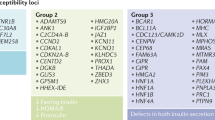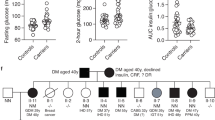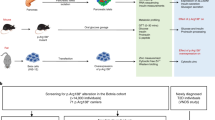Abstract
Type 2 diabetes is a polygenic and genetically heterogenous disease1. The age of onset of the disease is usually late and environmental factors may be required to induce the complete diabetic phenotype. Susceptibility genes for diabetes have not yet been identified. Islet-brain-1 (IB1, encoded by MAPK8IP1), a novel DNA-binding transactivator of the glucose transporter GLUT2 (encoded by SLC2A2), is the homologue of the c-Jun amino-terminal kinase-interacting protein-1 (JIP-1; refs 2,3,4,5). We evaluated the role of IB1 in β-cells by expression of a MAPK8IP1 antisense RNA in a stable insulinoma β-cell line. A 38% decrease in IB1 protein content resulted in a 49% and a 41% reduction in SLC2A2 and INS (encoding insulin) mRNA expression, respectively. In addition, we detected MAPK8IP1 transcripts and IB1 protein in human pancreatic islets. These data establish MAPK8IP1 as a candidate gene for human diabetes. Sibpair analyses performed on 149 multiplex French families with type 2 diabetes excluded MAPK8IP1 as a major diabetogenic locus. We did, however, identify in one family a missense mutation located in the coding region of MAPK8IP1 (S59N) that segregated with diabetes. In vitro , this mutation was associated with an inability of IB1 to prevent apoptosis induced by MAPK/ERK kinase kinase 1 (MEKK1) and a reduced ability to counteract the inhibitory action of the activated c-JUN amino-terminal kinase (JNK) pathway on INS transcriptional activity. Identification of this novel non-maturity onset diabetes of the young (MODY) form of diabetes demonstrates that IB1 is a key regulator of β-cell function.
This is a preview of subscription content, access via your institution
Access options
Subscribe to this journal
Receive 12 print issues and online access
$209.00 per year
only $17.42 per issue
Buy this article
- Purchase on Springer Link
- Instant access to full article PDF
Prices may be subject to local taxes which are calculated during checkout



Similar content being viewed by others
References
Kahn, B.B. & Rossetti, L. Type 2 diabetes—who is conducting the orchestra? Nature Genet. 20, 223– 225(1998).
Bonny, C., Nicod, P. & Waeber, G. IB1, a JIP-1 related nuclear protein present in insulin-secreting cells. J. Biol. Chem. 273, 1843– 1846 (1998).
Dickens, M. et al. A cytoplasmic inhibitor of the JNK signal transduction pathway . Science 277, 693–696 (1997).
Whitmarsh, A.J., Cavanagh, J., Tournier, C., Yasuda, J. & Davis, R.J. A mammalian scaffold complex that selectively mediates MAP kinase activation. Science 281, 1671–1674 (1998).
Mooser, V. et al. Genomic organization, fine mapping and expression of the human islet-brain 1(IB1)/c-Jun-amino-terminal kinase interacting protein-1 (JIP-1) gene. Genomics 55, 202– 208 (1999).
Thorens, B., Weir, G.C., Leahy, J.L., Lodish, H.F. & Bonner-Weir, S. Reduced expression of the liver/β-cell glucose transporter isoform in glucose-insensitive pancreatic β cells of diabetic rats. Proc. Natl Acad. Sci. USA 87, 6492 –6496 (1990).
Thorens, B., Wu, Y.J., Leahy, J.L. & Weir, G.C. The loss of GLUT2 expression by glucose-unresponsive B cells of db/db mice is reversible and is induced by the diabetic environment. J. Clin. Invest. 90, 77–85 (1992).
Guillam, M.-T. et al. Early diabetes and abnormal postnatal pancreatic islet development in mice lacking GLUT-2. Nature Genet. 17, 327–330 (1997).
Waeber, G., Thompson, N., Haefliger, J.-A. & Nicod, P. Characterization of the murine high Km glucose transporter GLUT2 gene and its transcriptional regulation by glucose in a differentiated insulin-secreting cell line. J. Biol. Chem. 269, 26912– 26919 (1994).
Bonny, C., Thompson, N., Nicod, P. & Waeber, G. Pancreatic-specific expression of the glucose transporter type 2 gene: identification of cis -elements and islet-specific trans-acting factors. Mol. Endocrinol. 9, 1413–1426 (1995).
Waeber, G., Thompson, N., Nicod, P. & Bonny, C. Transcriptional activation of the GLUT2 gene by the IPF-1/STF-1/IDX-1 homeobox factor. Mol. Endocrinol. 10, 1327–1334 (1996).
Waeber, G. et al. Insulin secretion is regulated by the glucose-dependent production of islet β cell macrophage migration inhibitory factor. Proc. Natl Acad. Sci. USA 94, 4782–4787 (1997).
Zouali, H. et al. Linkage analysis and molecular scanning of glucokinase gene in NIDDM families. Diabetes 42, 1238– 1245 (1993).
Hani, E.H. et al. Defective mutations in the insulin promoter factor-1 (IPF-1) gene in late-onset type 2 diabetes mellitus. J. Clin. Invest. 104, R41–R48 (1999).
Inagaki, N. et al. C-jun represses the human insulin promoter activity that depends on multiple cAMP response elements. Proc. Natl Acad. Sci. USA 89, 1045–1049 (1992).
Henderson, E. & Stein, R. c-jun inhibits transcriptional activation by insulin enhancer, and the insulin control element is the target of control . Mol. Cell. Biol. 14, 655– 662 (1994).
Robinson, G.L., Henderson, E., Massari, M.E., Murre, C. & Stein, R. c-Jun inhibits insulin control element-mediated transcription by affecting the transactivation potential of the E2A gene products . Mol. Cell. Biol. 15, 1398– 1404 (1995).
Widman, C., Gerwins, P., Lassignal Johnson, N., Jarpe, M.B. & Johnson, G.L. MEKK1, a substrate for DEVD-directed caspases, is involved in genotoxin-induced apoptosis. Mol. Cell. Biol. 18, 2416–2429 ( 1998).
Ip, Y.T. & Davis, R.J. Signal transduction by the c-Jun N-terminal kinase (JNK). From inflammation to development. Curr. Opin. Cell Biol. 10, 205–219 (1998).
Widmann, C., Johnson, N.L., Garner, A.M., Smith, R.J. & Johnson, G.L. Potentiation of apoptosis by low dose stress stimuli in cells expressing activated MEK kinase 1. Oncogene 15, 2439–2447 ( 1997).
Ohlsson, H., Karlsson, K. & Edlund, T. IPF1, a homeodomain-containing transactivator of the insulin gene. EMBO J. 12, 4251– 4259 (1993).
Pellet, J.-B. et al. Spatial, temporal and subcellular localization of islet-brain 1 (IB1), a homologue of JIP-1, in mouse brain. Eur. J. Neurosci. 12, 1–12 (2000 ).
Gremlich, S., Bonny, C., Waeber, G. & Thorens, B. Fatty acids decrease IDX-1 expression in rat pancreatic islets and reduce GLUT2, glucokinase, insulin and somatostatin levels. J. Biol. Chem. 272, 30261–30269 (1997).
Jonas, J.-C. et al. Chronic hyperglycemia triggers loss of pancreatic β cell differentiation in an animal model of diabetes. J. Biol. Chem. 274, 1412–1421 ( 1999).
Wang, H.P. & Iynedjian, P. Modulation of glucose responsiveness of insulinoma β-cells by graded overexpression of glucokinase. Proc. Natl Acad. Sci. USA 94, 4372– 4377 (1997).
Vionnet, N. et al. Genetics of NIDDM in France: studies with 19 candidate genes in affected sib pairs. Diabetes 46, 1062 –1068 (1997).
Report of the Expert Committee on the diagnosis and classification of diabetes mellitus. Diabetes Care 20, 1183–1197 (1997).
Haseman, J.K. & Elston, R.C. The investigation of linkage between a quantitative trait and a marker locus. Behav. Genet. 2, 3–19 (1972).
O'Connel, J.R. & Weeks, D.E. The VITESSE algorithm for rapid exact multilocus linkage analysis via genotype set-recording and fuzzy inheritance. Nature Genet. 11, 402 –408 (1995)
Acknowledgements
We thank J. Oberholzer for freshly isolated human pancreatic islets; P. Fontana for help in statistical analysis; and P. Gallina for collecting diabetic families and patient data. G.W., C.B. and V.M. are supported by the Swiss National Science Foundation (grants 32-48916.96, 32-94471.95 and 32-54119.98) and the Placide Nicod and Botnar Foundations.
Author information
Authors and Affiliations
Corresponding author
Rights and permissions
About this article
Cite this article
Waeber, G., Delplanque, J., Bonny, C. et al. The gene MAPK8IP1, encoding islet-brain-1, is a candidate for type 2 diabetes. Nat Genet 24, 291–295 (2000). https://doi.org/10.1038/73523
Received:
Accepted:
Issue Date:
DOI: https://doi.org/10.1038/73523
This article is cited by
-
Areca catechu-(Betel-nut)-induced whole transcriptome changes in a human monocyte cell line that may have relevance to diabetes and obesity; a pilot study
BMC Endocrine Disorders (2021)
-
Metabolic Messengers: tumour necrosis factor
Nature Metabolism (2021)
-
Inflammation, metaflammation and immunometabolic disorders
Nature (2017)
-
Copy number variants encompassing Mendelian disease genes in a large multigenerational family segregating bipolar disorder
BMC Genetics (2015)
-
Role of ceramide in diabetes mellitus: evidence and mechanisms
Lipids in Health and Disease (2013)



